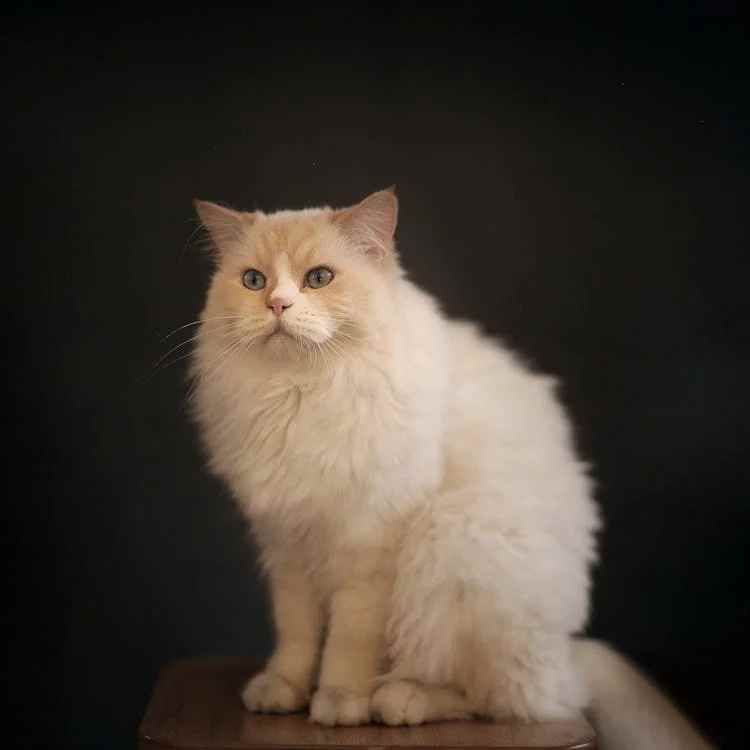We keep Ragdolls indoors because of their gentle nature and susceptibility to outdoor dangers. They love cozy homes and are happy lounging by windows or playing with toys inside. Their strong bonds with us make them ideal companions for safe indoor living. By prioritizing their well-being, we guarantee they’re protected from potential risks and can thrive happily.
Being indoor cats enhances their safety, health, and emotional connection with human companions. If you want to know more about why Ragdolls are best suited for indoor environments, continue exploring the reasons behind this decision.
Ragdolls’ Gentle Temperament
We find Ragdolls to be known for their exceptionally gentle temperament. These indoor cats thrive in safe, cozy environments, preferring the comforts of home over the outdoor dangers they might encounter. Ragdolls exhibit distinct indoor behaviors compared to their outdoor counterparts.
They’re content to lounge in sunny spots, curl up on soft blankets, and engage in playful activities indoors. Their calm demeanor and lack of aggression make them ideal companions for families with children or other pets. Unlike outdoor cats, Ragdolls tend to be less territorial and are less likely to engage in hunting behaviors.
Ragdolls’ Vulnerability Outdoors
When Ragdolls venture outdoors, their vulnerability becomes apparent due to their trusting nature and lack of street smarts. While these cats may possess a gentle temperament ideal for indoor living, the outside world presents various dangers that they are ill-equipped to handle.
Outdoor dangers such as busy roads, aggressive animals, and exposure to diseases pose significant risks to Ragdolls. Their friendly demeanor and lack of predatory instincts make them easy targets for larger animals or even malicious humans.
Without the safety and security of an indoor environment, Ragdolls can quickly fall victim to predatory risks. To safeguard their well-being, it’s essential to keep Ragdolls as indoor cats where they can thrive in a controlled and protected environment.
| Outdoor Dangers | Predatory Risks |
|---|---|
| Busy roads | Aggressive animals |
| Exposure to diseases | Malicious humans |

Ragdolls’ Adaptability to Indoor Living
Ragdolls’ adaptability to indoor living is evident in their ability to thrive in a controlled and secure environment, away from the risks and dangers of the outside world. These cats are content with a cozy spot by the window, indulging in playful activities like chasing toys or climbing a cat tree.
Providing various enrichment options, such as puzzle feeders or interactive toys, can keep Ragdolls mentally stimulated and physically active. With their gentle and affectionate nature, Ragdolls are well-suited for indoor life, forming strong bonds with their human companions.
Ragdolls’ Bonding Behavior
Their bonding behavior is characterized by their affectionate and loyal nature towards their human companions. Ragdolls excel in forming strong emotional connections with their owners, seeking out human interaction and companionship.
These feline companions are known for their exceptional socialization skills, which enable them to easily bond with both humans and other pets in the household. The bonding benefits of having a Ragdoll cat include increased happiness and reduced stress levels for their owners.
Through their loving and affectionate nature, Ragdolls create a deep sense of attachment with their human family members, fostering a strong bond built on trust and mutual understanding. This unique bonding behavior makes Ragdolls cherished companions in any loving home.
Ragdolls’ Safety and Well-being
Let’s now focus on ensuring the safety and well-being of Ragdoll cats in our homes.
Ragdolls thrive in an indoor environment for several reasons:
- Health benefits: Indoor environments protect Ragdolls from potential dangers like predators, diseases, and traffic accidents.
- Behavioral risks: Outdoor exposure can lead to behavioral issues such as aggression, anxiety, and territorial behavior.
- Mental stimulation: Providing enriching indoor activities like interactive toys and climbing structures can keep Ragdolls mentally stimulated.
- Regular veterinary care: Indoor cats like Ragdolls still need regular vet check-ups and vaccinations to maintain their health and well-being.
Frequently Asked Questions
Are Ragdolls Hypoallergenic?
Yes, Ragdolls are often considered hypoallergenic due to their low shedding and less dander production. However, individual reactions may vary. Despite being indoor cats, Ragdolls still need exercise to stay healthy and happy.
Do Ragdolls Require a Lot of Grooming?
We find that Ragdolls do require regular brushing to prevent hair matting and maintain a healthy coat. Grooming frequency can vary, but it helps control shedding and keeps their fur looking sleek and tidy.
Can Ragdolls Be Left Alone for Long Periods?
Ragdolls can be left alone for long periods, but they do enjoy companionship. While they are independent, it’s advisable to make sure they have company or interactive toys to keep them happy and engaged.
Are Ragdolls Good With Children and Other Pets?
Ragdolls are typically gentle and good-natured. They tend to get along well with children and other pets, including dogs. Supervision is always advised when Ragdolls interact with toddlers to guarantee safety and harmony.
How Can I Keep My Ragdoll Entertained Indoors?
To keep our Ragdoll entertained indoors, we utilize interactive toys and puzzle feeders for mental stimulation. We also have cat trees and scratching posts for physical activity. Providing a variety of enrichment options is crucial.
Conclusion
So, why are ragdolls indoor cats?
Well, it’s because they’re gentle, vulnerable, adaptable, and love bonding with their humans. Plus, let’s face it – they’re just too darn cute to risk letting them roam outside. Who’d want to put such a precious and loving pet in harm’s way?
Indoor living is the way to go for these amazing feline companions.

Hey guys, My name is Simon Smith. I’m from Canada and live near Victoria
I live with my sweet family and have 20+ Ragdolls of different types. I love them as my children. My profession is as a hotel manager.
I love to keep Ragdolls and grow their breeder case. I have 7 years of experience.
I’m an expert in cat care. So, I’m here to provide you with new information about my cats daily. This is my blog website, so I request that you kindly visit our site daily.
If you’re a Ragdolls lover and you have any questions or confusion about cats, text me on the Contact Us page or Gmail.
Thank u
